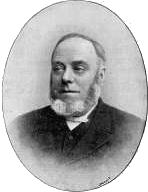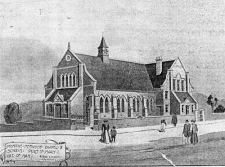
Rev William Harris
PM World 7 Mar 1907 pp 155
By Rev. W. CURRY.
AS Castletown and the adjacent places which form the Circuit were the first to be missioned, we have already given an account of their beginning. It remains, however, to notice some of the later developments.
Castletown stood at the head of the places forming the Isle of Man Circuit for many years. In 1851 it was formed into a Branch of Douglas Circuit, And not until 1868 did it become a Circuit. This slow progress was not because of a lack of faithful service on the part of our people, but because of the stagnation in the growth of the population. Castletown itself has today only 150 more inhabitants than in 1821. And, as far as our Church is concerned, there are fewer members in Castletown than in 1824, when the first chapel was opened. The only places which have increased in population are Port St. Mary and Port Erin, which have become favourite pleasure resorts. From the villages there has been a continuous stream of emigration, and our members have gone out to England, America, Africa, and Australia. :The Circuit has faced its difficulties, and never ceased to make inroads on the kingdom of darkness.

Rev William Harris
In 1866 a remarkable revival took place in the Circuit. The minister, Rev. W. Harris, was preaching at the ordinary service at Croit-e-Caley, when a remarkable unction rested on the people, and a woman was so overcome that she fell to the floor and cried aloud for mercy. The friends talked to her and prayed with her, but she could not find liberty. As they left the chapel Mr. Harris met the miller, Mr. Mylchraine, who said, "We are going to have a revival I am sure." "Why do you-think so?" Mr. Harris asked. "Well," answered the miller, "I have seen a strange thing tonight, a bright light, like a big flame of fire. I thought the mill was on fire, but when I got near I saw it was right above the little chapel."
This was a remarkable coincidence-while within a wonderful spiritual influence rested on the people, without, seen by an eye witness who knew nothing of what was going on in the chapel, was a light as a. flame of fire resting on the chapel.
And sure enough, the revival broke out and spread like fire all over the Circuit, to Colby, Port St. Mary, Port Erin, Balla Pheson, and Castletown. It was like the Welsh revival - the ordinary means were suspended and the meetings went on all night. Over 400 were gathered into the churches on the Circuit; other Churches benefited also, the Wesleyans having a large in-gathering This revival led to the enlarging of the chapels at Colby and Port St. Mary, and the opening of missions at Bradda and Cregnesh.
In the following year 1867, another revival took place at Ballasalla, conducted by Phil Clucas. Large numbers attended from near and far. The services lasted nine weeks, and many of the unsaved were gathered into the Church. It was the year following that the Branch considered itself strong enough to become a separate Circuit.
It has been the almost invariable rule that our Church has gone forward, not by slow, gradual development, but by leaps and bounds, so that every forward movement has been launched on the flowing tide of a revival.
Very considerable improvement has taken place in the chapel property in the Circuit. In Castletown a handsome building was erected in 1890, at a cost of £2,500, and a new organ has recently been put in, costing £300, half of which has been borne by Mr. A. Carnegie, the only gift he has made to the Island, secured by the energetic minister, the Rev. J. W. Lancaster.

[unlabelled - Architect's drawing of Port St. Mary PM
Church]
At Port St Mary - once a renowned fishing village known as Port-le-Murry, now become a favourite watering-place - a beautiful new chapel and school have been built, in 1903, to seat 320, costing £2,100, chiefly through the efforts of the Rev. W. Harris.
At Port Erin - rapidly growing as a summer resort where one of the first chapels was built in 1823, a commodious and up-to-date structure was erected in 1902 at a cost of £2,000. It is well situated,- and will meet the needs of the many visitors to this beauty spot.
In 1906 the Castletown Circuit reported: Members, 264; local preachers, 25; one minister and one superintendent minister; one manse, seven chapels, with sittings for 1,802, valued at £9,860; hearers, 1,080; scholars, 548; and 121 teachers.
No minister has spent so much of his active ministry in Manxland as the Rev. W: Harris. He has travelled on the Island fifteen years. This period he has divided among three of the Circuits- Peel, Douglas, and Castletown. He has been stationed at Peel four times. He has preached in every chapel on the Island, and has had to do with the building or enlarging of not a few. Successful in all his Circuits, he has been eminently successful among the Manx people; hundreds have been converted under his ministry, and, more than any other man, he has prompted young men to become preachers and officials. He has been a strong man, capable of great endurance; a great family visitor and good organiser, and, in spite of much domestic affliction, toiled incessantly for the Circuits. His sermons were as strong meat for the hungry, deep thoughts on the things of God, declared with an infectious earnestness and conviction. In the latter days Mr. Harris has retired to Port St. Mary, where his activity has been unabated, and has resulted in the building of the new chapel.

Rev. J.W. Lancaster (Castletown)
Laxey is the youngest and smallest of the Circuits on the Island. It was made from Douglas in 1893 and is composed of three places-Laxey, Baldrine, and Balldhoon. The Circuit has not much opportunity for extension. The few adjacent villages are supplied with chapels, and their population is either stationary or declining. Laxey has suffered through the comparative failure of the lead mines, which for many years formed the staple industry. The electric railway, which passes through Laxey, from Douglas to Ramsey, has benefited the village, and it is hoped that some day a landing pier for steamers will be built, and Laxey will become an important visiting centre.
Attention has already been called to the missioning of Laxey in the early days, and little further need be said. Once the Society was formed, the work went forward, and a strong, enthusiastic church was built up, the history of which is a series of stirring revivals.
In 1841, when the mines were in full swing, a good work broke out among the miners. Their besetting sin was drunkenness, and our people formed a temperance society, and persuaded a large number to sign the pledge. This was followed by special services, and a revival resulted in over 100 conversions.
Another great revival took place when George Herod was superintendent of the Douglas Circuit, 1856-7. He was very popular at Laxey, and every time he preached on a Sunday night the chapel was packed and seats were placed in the aisle. In the revival most of the young people in the village were converted .
A revival conducted by Phil Clucas is remembered by several. The missioner was much annoyed by certain young men at the door. He left the pulpit, and, going to the door, got hold of the ringleader, brought him to the front, and compelled him to kneel. The young man was converted, and so great, was the interest aroused that services were held every night for two months, and many converted.
Another gracious work which deserves mention was in 1881 conducted by the Rev W. Brass, who was the second minister of the Circuit. From this revival a strong Bible Class was formed, which existed several years and did much good.
In 1870 the present chapel at Laxey, called Minorca, was opened, the Rev. David Tuton preached the opening sermon during the District Meeting in Douglas. The new Sunday school, recently-built when Rev. A. W. Ayre was minister; at a cost of £1,450, is a model, both for elegance end utility.
Our church at Baldrine, a village two miles on the Douglas side of Laxey, was originated by a few zealous Primitive Methodists, who commenced cottage prayer meetings as early as 1828. Mrs. Kelly opened her house, where a preaching service was held every fortnight on week-nights for nineteen years. The class which was formed was led by Thomas Lewin. The revival of 1841-3 visited the neighbourhood; the services were held in a barn, large numbers attended, and many were converted. The outcome of the revival was the raising of the Society to fifty strong, the beginning of a Sunday school, of a Sunday evening service, and, in 1843, the building of a little chapel. The chapel was largely built by free labour, and materials given by the farmers who had been converted and joined the Society.
This small sanctuary served until 1884, when a larger one was built on the opposite side of the road. At the building of this chapel there wonderfull display of practical sympathy; the people came from all parts of the district and willingly gave of their money that the house of the Lord might be builded.
(to be continued)
|
|
||
|
|
||
|
Any comments, errors or omissions
gratefully received The
Editor |
||